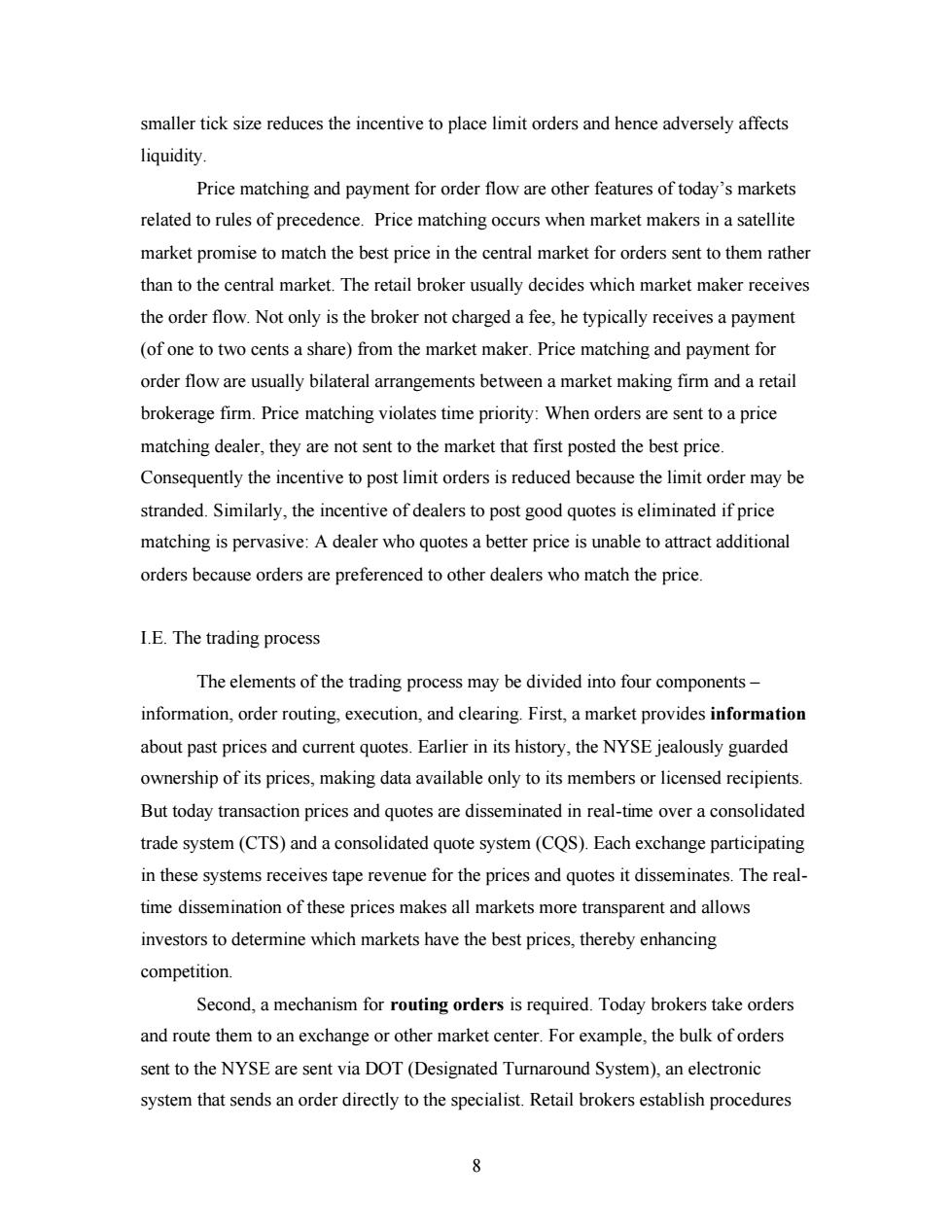正在加载图片...

smaller tick size reduces the incentive to place limit orders and hence adversely affects liquidity. Price matching and payment for order flow are other features of today's markets related to rules of precedence.Price matching occurs when market makers in a satellite market promise to match the best price in the central market for orders sent to them rather than to the central market.The retail broker usually decides which market maker receives the order flow.Not only is the broker not charged a fee,he typically receives a payment (of one to two cents a share)from the market maker.Price matching and payment for order flow are usually bilateral arrangements between a market making firm and a retail brokerage firm.Price matching violates time priority:When orders are sent to a price matching dealer,they are not sent to the market that first posted the best price. Consequently the incentive to post limit orders is reduced because the limit order may be stranded.Similarly,the incentive of dealers to post good quotes is eliminated if price matching is pervasive:A dealer who quotes a better price is unable to attract additional orders because orders are preferenced to other dealers who match the price. I.E.The trading process The elements of the trading process may be divided into four components- information,order routing,execution,and clearing.First,a market provides information about past prices and current quotes.Earlier in its history,the NYSE jealously guarded ownership of its prices,making data available only to its members or licensed recipients. But today transaction prices and quotes are disseminated in real-time over a consolidated trade system(CTS)and a consolidated quote system(CQS).Each exchange participating in these systems receives tape revenue for the prices and quotes it disseminates.The real- time dissemination of these prices makes all markets more transparent and allows investors to determine which markets have the best prices,thereby enhancing competition. Second,a mechanism for routing orders is required.Today brokers take orders and route them to an exchange or other market center.For example,the bulk of orders sent to the NYSE are sent via DOT(Designated Turnaround System),an electronic system that sends an order directly to the specialist.Retail brokers establish procedures8 smaller tick size reduces the incentive to place limit orders and hence adversely affects liquidity. Price matching and payment for order flow are other features of today’s markets related to rules of precedence. Price matching occurs when market makers in a satellite market promise to match the best price in the central market for orders sent to them rather than to the central market. The retail broker usually decides which market maker receives the order flow. Not only is the broker not charged a fee, he typically receives a payment (of one to two cents a share) from the market maker. Price matching and payment for order flow are usually bilateral arrangements between a market making firm and a retail brokerage firm. Price matching violates time priority: When orders are sent to a price matching dealer, they are not sent to the market that first posted the best price. Consequently the incentive to post limit orders is reduced because the limit order may be stranded. Similarly, the incentive of dealers to post good quotes is eliminated if price matching is pervasive: A dealer who quotes a better price is unable to attract additional orders because orders are preferenced to other dealers who match the price. I.E. The trading process The elements of the trading process may be divided into four components – information, order routing, execution, and clearing. First, a market provides information about past prices and current quotes. Earlier in its history, the NYSE jealously guarded ownership of its prices, making data available only to its members or licensed recipients. But today transaction prices and quotes are disseminated in real-time over a consolidated trade system (CTS) and a consolidated quote system (CQS). Each exchange participating in these systems receives tape revenue for the prices and quotes it disseminates. The realtime dissemination of these prices makes all markets more transparent and allows investors to determine which markets have the best prices, thereby enhancing competition. Second, a mechanism for routing orders is required. Today brokers take orders and route them to an exchange or other market center. For example, the bulk of orders sent to the NYSE are sent via DOT (Designated Turnaround System), an electronic system that sends an order directly to the specialist. Retail brokers establish procedures